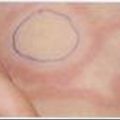7.11 Herniae
Types of herniae
Inguinal
The incidence of inguinal herniae in children has been reported to be between 0.8% and 4.4%,1 rising to 18.9% to 30% of preterm infants.2,3 Inguinal herniae are six times more common in boys and are more common in twins.1,4 Around 1 in 10 inguinal hernias are non-reducible at presentation, although a careful history from the parents will often elucidate earlier signs and symptoms. In this group, over two-thirds are under 1 year of age.
In children, inguinal herniae are almost always indirect.5 The hernia exits the peritoneal cavity via the internal inguinal ring to enter the inguinal canal, leaving the canal via the external inguinal ring. The sac is intimately related to the contents of the spermatic cord. It is compression of the testicular vessels by hernial contents that may render the testis ischaemic. In contrast, in females the risk of ischaemia to the ovary and adnexae usually occurs as a result of torsion of these structures within the hernial sac.
Rarely, direct inguinal herniae may occur, with some series reporting an incidence of up to 5%.6 Typically, these children have either had previous inguinal surgery, a connective tissue disorder or were delivered at less than 30 weeks’ gestation. The clinical management and surgical approach remains similar to indirect inguinal herniae.
Inguinal herniae usually present as a swelling in the inguinal region first noticed by the carer when changing or bathing the child, especially if crying or straining.7 The swelling may extend into the scrotum in boys or the labia majora in girls. Persistent tachycardia, overlying erythema and marked tenderness suggest an irreducible hernia complicated by ischaemia.8 Occasionally, an irreducible hernia may present with vomiting and abdominal distension as a result of intestinal obstruction.
Femoral
Femoral herniae are rare in children, accounting for between 0.4 and 1.1% of all groin hernias.1,9 They are often not diagnosed prior to surgery and are one cause of recurrent ‘inguinal’ herniae in children. Typically, most present between 4 and 10 years of age and there is an equal sex incidence. Clinically, the hernia presents as a swelling that is inferior and lateral to the pubic tubercle. As in adults, femoral herniae are associated with a high incidence of complications, so prompt surgical intervention is required.
Umbilical and paraumbilical herniae
Umbilical herniae are very common, occurring in up to 18.5% of infants under 6 months of age.5 They are more common in Afro-Caribbean children and in premature infants, when the incidence rises to between 41.6 and 75%.10,11 The vast majority of umbilical defects appear to close spontaneously with increasing age, largely irrespective of the size of the defect. Given the very low risk of the hernia becoming non-reducible, surgical repair is only indicated for those herniae that persist beyond 3 and 5 years of age, or in the very few that present with symptoms.12
Treatment
Indirect inguinal hernias have traditionally been treated by a herniotomy, with removal of the hernial sac following its ligation at the internal ring. This procedure has a high success rate with a low incidence of important complications such as injury to the vas and subsequent testicular atrophy.6 Laparoscopic correction involves suture ligation of the hernial sac from within the abdominal cavity and appears to have a slightly higher recurrence rate than open surgery.13 Direct hernias are generally repaired primarily without the use of mesh.6
 The role of routine contralateral inguinal exploration in children with a unilateral inguinal hernia remains controversial. A recent systematic review suggested that, as the overall risk of developing a metachronous hernia in childhood was 7.2%, routine contralateral exploration was not warranted.14
The role of routine contralateral inguinal exploration in children with a unilateral inguinal hernia remains controversial. A recent systematic review suggested that, as the overall risk of developing a metachronous hernia in childhood was 7.2%, routine contralateral exploration was not warranted.141 Bronsther B., Abrahams M.W., Elboim C. Inguinal hernia in children – a study of 1000 cases and review of the literature. J Am Med Women’s Ass. 1992;27:522-525.
2 Darlow B.A., Dawson K.P., Mogridge N. Inguinal hernia and low birth weight. N Z Med J. 1987;100:492-494.
3 Harper R.G., Garcia A., Sia C. Inguinal hernia: A common problem of premature infants weighing 1000 grams or less at birth. Paediatrics. 1975;56:112-115.
4 Bawkin H. Indirect inguinal hernia in twins. J Pediatr Surg. 1971;6:165-168.
5 Rescorla F.J. Hernias and umbilicus. In: Oldham K.T., Colombani P.M., Foglia R.P., editors. Surgery of infants and children. Philadelphia: Lippincott-Raven; 1997:1069-1081.
6 Brandt M.L. Pediatric hernias. Surg Clin North Am. 2008;88:27-43.
7 Johnstone J.M.S. Hernia in the neonate. In: Freeman N.V., Burge D.M., Griffiths M., Malone P.S.J., editors. Surgery of the newborn. Edinburgh: Churchill Livingstone; 1994:321-330.
8 Kapur P., Caty M.G., Glick P.L. Paediatric hernias and hydroceles. Pediatr Clin North Am. 1998;45:773-789.
9 Radcliffe G., Stringer M.D. Reappraisal of femoral hernia in children. Br J Surg. 1997;84:58-60.
10 Crump E.P. Umbilical hernia: Occurrence of the infantile type in Negro infants and children. J Pediatr. 1952;40:214-223.
11 Vohr B.R., Rosenfeld A.G., Oh W. Umbilical hernia in low birth weight infants (less than 1500 grams). J Pediatr. 1977;90:807-808.
12 Meier D.E., OlaOlorun D.A., Omodele R.A., et alTarpley J.L. Incidence of umbilical hernia in African children: Redefinition of ‘normal’ and re-evaluation of indications for repair. World J Surg. 2001;25:645-648.
13 Zitsman J.L. Pediatric minimal-access surgery: update 2006. Pediatrics. 2006;118:304-308.
14 Ron O., Eaton S., Pierro A. Systematic review of the risk of developing a metachronous contralateral inguinal hernia in children. Br J Surg. 2007;94:804-811.




